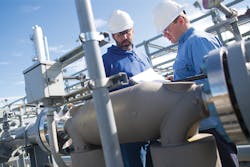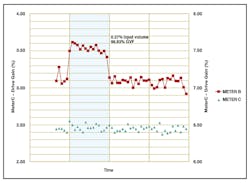Coriolis flowmeters for wet gas measurement
The rapid growth in unconventional gas production — namely fracking — in recent years has brought with it an increased demand for a method of measuring flow rates of both gas and liquid at the wellhead that is more effective and reliable than traditional methods, while remaining reasonably accurate. Current methods used are primarily separator or compensated differential pressure.
Some multiphase flowmeters (MPFMs) are capable of measuring output flow rates of gas and liquid hydrocarbons, and water separately, but they can have higher upfront costs and require more expertise to configure than traditional measurement technologies. They also tend to require compositional fluid analysis, which can be burdensome in fields where composition varies from well to well and changes over time. This requirement makes MPFMs impractical as a long-term solution.
This is particularly true where differentiating water from liquid hydrocarbon may not be necessary, if the liquid is a small enough fraction of the flow rate in the wet gas process.
Efficiently managing fields and optimizing production requires real-time insight into conditions at the wellhead; therefore, it is essential to have the best tools available.
Figure 1. Coriolis meters with a large U shape can detect and account for even miniscule amounts of liquid, while low-profile design meters may simply overread.
Reservoir management challenges
Effective reservoir management over the life of a field requires regular measurement of individual wells and injectors. Generally, these measurements are performed on a monthly — or less frequent — basis, which means the data gathered is only a snapshot of what might be happening and often won’t indicate changes that might occur. Whether in its initial production or late in life, a single well’s production can change dramatically. This change can lead to production engineers sifting through scarce data to find the well that’s causing problems and formulate a plan of action to return it to the target production rate.
The search for the source of a water breakthrough or a failed downhole completion can be laborious, slow work, as well as expensive to find in the available data while engineers wait for more well tests to trickle in. Because of this, more and more operators are considering direct wellhead measurement options to ensure optimal recovery and quick response to individual well production issues.
Direct wellhead measurement
Though it may seem obvious that the solution to the above problem would be direct wellhead measurement, there are some obstacles to implementation. Primary among those is cost. The most commonly used flowmeters represent a significant investment for companies in both initial investment and maintenance, which is particularly costly when using nuclear-based devices.
To date, the adoption rates for multiphase measurement technology have been notably higher for subsea applications where the initial investment is seen as acceptable considering the expected return on investment.
Alternate forms of capturing this measurement at the wellhead include partial separation skids in which a gas-liquid separation is employed on a skid setup, allowing inherently single-phase devices to more accurately gauge gas and liquid rates individually. But while partial skids can offer reasonable accuracy, the meters used often have a narrow operating range and require a significant footprint onsite, as well as a sizeable investment to build the custom skids and maintain the individual devices on it.
The Coriolis option
Recent research, building on more than 10 years of development in Coriolis multiphase performance, indicates that the Coriolis flowmeter is a viable solution for direct wellhead measurement. Coriolis meters are well-understood and accepted in the oil and gas industry in refinery and custody transfer applications, and they have a long track record of consistent performance under a range of conditions.
In the past, research has focused mainly on small amounts of gas in liquid processes, but with Coriolis meters’ ability to measure multiple variables, such as mass flow, density, temperature, tube damping (an indicator of phase fraction conditions) and time, it is clear that these meters are also capable of measuring liquid in gas. This type of measurement works by combing the variables at the wellhead with readily available process variables, such as density of liquid and gas at standard conditions.
With a Coriolis meter it is possible to get real-time insight into well behavior and to apportion the overall mass flow to gas and liquid components. The algorithm suggested is one that uses a combination of opportunistic sampling — based on onboard diagnostics — with calculations to determine gas and liquid rates separately, and convert between line and standard conditions. It also relies on signals from a sensor element design that is optimized for use in multiphase applications.
Improved gas measurement through drive gain
The performance of Coriolis meters can be greatly improved by using drive gain, or drive power, to detect where there is single- or two-phase flow in the meter. Drive gain is proportional to the power used to vibrate the meter’s tubes. In two-phase flow, much of the energy used to drive the flow tubes goes into the relative motion between the liquid and gas phases, requiring an increase in drive power to maintain constant tube amplitude. Due to limited available power because of intrinsically safe limits, drive gain quickly reaches 100 percent with small amounts of gas — when measuring for entrained gas — at which point tube amplitude begins to drop.
The same techniques that can detect entrained gas in a liquid process can be used to detect liquid mist in a gas process, when using certain Coriolis sensor designs. Testing shows drive gain in Coriolis meters with a large U-shaped geometry are sensitive to even small amounts of liquid. Figure 1 shows that with as little as 0.027 percent liquid by volume, drive gain is a clear and immediate indicator in one Coriolis meter, but does not register with the other. Even with half as much liquid, drive gain is still unusable as an indicator, although it is a subtle change.
Once liquid is detected, an algorithm similar to one used for liquid processes with entrained gas can be used to determine gas flow rate measurement.
Large errors in gas mass flow measurement might be incurred by measuring liquid as well as gas — often called "over-read." When two-phase conditions are detected by increases in drive gain, to avoid over-read one can substitute the mass flow rate from a few seconds before the two-phase conditions for the bulk measurement, until the process returns to single phase.
If the mass flow rate of the dry gas before and after the wet gas period is different, then a small adjustment can be made to the flow rate, so that the total will reflect a linear change in gas flow rather than a step change.
Looking to the future
Research is ongoing, both in the lab and the field, but early indications are that Coriolis meters used in wet gas processes deliver accuracy that is better than existing differential pressure (dP) measurement technology and, under some conditions, is comparable to separators with single-phase flow measurement. Coriolis technology offers the added benefit of lower maintenance requirements and does not rely on lab sampling to provide compositional fluid properties, and users do not need to input phase fraction or the Lockhart-Martinelli parameter (a dimensionless number used in internal two-phase flow calculations).
With ongoing research, designers hope to better understand potential limiting factors and to further improve performance so that Coriolis devices can provide the primary solution to measuring wet gas, which will offer the industry a reliable and proven measurement tool as an alternative to the what’s commonly used today. Coriolis has the added benefit of offering onboard diagnostic tools which make tracking and diagnosing flow easier, thereby reducing the need for monthly inspections and data gathering. With Coriolis technology it’s possible to get both a snap shot view and long-term stats of well performance.
Justin Hollingsworth works in Innovation at Emerson Automation Solutions as the Application Research Engineering Manager. He is focused on creating solutions for flow and density measurement customers that address the unmet needs in challenging applications. Hollingsworth has experience in developing complex measurement and control systems in the aerospace, automotive and process industries.


